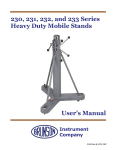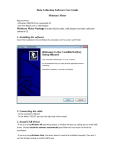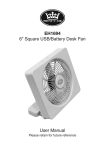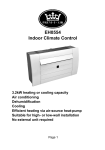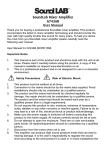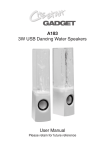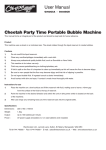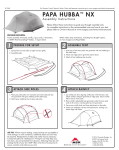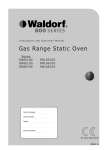Download - Brunson
Transcript
230, 231, 232, and 233 Series Heavy Duty Mobile Stands User’s Manual (Original Instructions) Instrument Company 15194 Rev E Helping the World Measure TM Since 1927 www.brunson.us 8000 E. 23rd Street Kansas City, MO 64129 Toll free: 877—MEASURE (877.632.7873) Tel: 816.483.3187 Fax: 816.241.1945 For Sales Assistance: [email protected] For Repair or Calibration Assistance: [email protected] Website: www.brunson.us Copyright 2013 Brunson Instrument Company Table of Contents Thank you for purchasing a Brunson Heavy Duty Mobile Stand. Remember that our customer support does not stop after shipment of a product—we are here to help you with any measurement challenges that you may have. 1 General Information 1 Safety Precautions 3 Unpacking and Setup 3 Moving and Positioning Your Stand 4 Stand Operation 5 Maintenance 6 Parts Diagram and List 8 Declaration of Conformity (CE Mark) 233 Series 231 Series 230 Series 232 Series User’s Manual 230, 231, 232, & 233 Series Heavy Duty Stands Congratulations and thank you for purchasing a Brunson heavy duty mobile stand. We believe that General Information our stands are the finest available, providing a rocksolid base to meet all of your metrology needs. We have been in the measurement industry since 1927, so we fully understand the importance of a stable, rugged, and durable metrology platform. At Brunson, HELPING THE WORLD MEASURE TM is more than our motto; it truly reflects our passion and dedication to the metrology world. Please take a moment to review this manual. It contains important safety and operational information for the stand. Refer to Figure 1 for part names referenced in the instructions. Finally, for future reference, please record the model and serial number for the stand in the space provided below. Model Number _______________________ Serial Number _______________________ Static (non-moving) stability: a. These stands are designed for use on level surfaces. Operating a stand on non-level surfaces increases the tipping hazard. Safety Precautions b. Instrumentation / equipment used with the stand should be centered over the axis of the Intermediate Tube. Extending unbalanced loads from the centerline axis increases the tipping hazard. Dynamic (moving) stability: a. Stands should be moved only when no instrumentation / equipment is attached and the intermediate tube is in its fully retracted (lowest) position. b. Stands should be moved by manually pushing or pulling no faster than a normal walking pace over smooth, level surfaces. Do not move a stand by pushing or pulling with a powered vehicle. c. Avoid sudden starts and stops. These stands are designed for indoor use only. Wind (or other external) loading was not considered when determining stability. Do not exceed the load capacity of the stand for any attached instrumentation / equipment. The maximum load capacity is listed in 230, 231, 232, and 233 Series Heavy Duty Mobile Stands 1 2 User’s Manual Table 1. Table 1 Model Stand weight Max load capacity lbs Kg lbs Kg 230 Series 185 84 150 68 231 Series 158 72 150 68 232 Series 587 267 150 68 233 Series 177 81 150 68 It is the responsibility of the end user to ensure that any instrumentation / equipment attached to the stand is safely secured. This is the safety alert symbol. This symbol alerts you to hazards that can hurt you and others, and/or cause damage to equipment. Additional information specific to the hazard will be included with this warning. WARNING! Take off the top and sides of the crate by removing the screws. Cut the three band clamps holding the tribrach legs down. With an overhead crane (or suitable alternative), lift the stand off the crate and place on a level surface (refer to TaUnpacking and Setup ble 1 for stand weights). If a foot pedal is present (Models 230, 231, and 233), ensure it is not engaged— the foot pedal should be “up” and free to move. Adjust the trivet bolts so that the casters touch the floor but do not bear any weight from the stand. You should be able to swivel each caster easily by hand. Tighten the jam nut on each trivet bolt. Ensure that the intermediate tube is in its lowest position and no instrumentation / equipment is attached to the stand. A foot pedal is used to extend the casters on the 230, Moving/Positioning Your Stand 231, and 233 Series stands. The 232 Series uses a handwheel. To extend the casters using the foot pedal, use your body weight and step on the larger pedal. The locking latch is spring-loaded and will “click” into place when the stand is locked onto the casters. For 232 Series Models, turn the handwheel until the casters extend to the ground. Manually push or pull the stand into the desired position. The stand should be positioned so that the tribrach leg on which the 230, 231, 232, and 233 Series Heavy Duty Mobile Stands 3 TIPPING HAZARD Move the stand over smooth, level surfaces only, with the intermediate tube in its lowest position and no instrumentation / equipment attached. Move the stand by manually pushing or pulling (no faster than a walking pace). Do not tow or push the stand with a powered vehicle. WARNING! foot pedal (or handwheel) is mounted points toward the midpoint of the work. Lower the stand onto the three trivets. If the floor is something other than concrete (e.g. wood, tiled, etc.), you may wish to use pads under the trivets to provide protection for the floor. Lower the stand by stepping down on the larger foot pedal to take the weight of the stand and rock your foot downward using the ball of your foot to release the spring-loaded latch. MAINTAIN SUFFICIENT PRESSURE ON THE FOOT PEDAL TO PREVENT THE STAND FROM SUDDENLY DROPPING ONTO THE FLOOR WHEN THE LATCH IS RELEASED. CRUSHING HAZARD Stands are very heavy! Prior to lowering the stand, ensure area below Tribrach is clear of all obstacles. WARNING! TRIPPING HAZARD Due to the size of the footprint necessary for stand stability, the legs of the stand can create a tripping hazard. WARNING! With the intermediate tube fully retracted, attach the instrument / measuring equipment to the stand. Stand Operation Raise the collar locking handle until the intermediate tube can be raised easily by rotating the control handles. To raise the intermediate tube, rotate the control handle counterclockwise (when looking at the hub). 4 User’s Manual ROTATING HAZARD The stands are equipped with an air-check mechanism to prevent rapid descent of the intermediate tube. However, until sufficient air pressure has built up to slow the descent of the intermediate tube, considerable force can be exerted by the free spinning control handle. Therefore, always lower the intermediate tube by applying a resistive force to the control handle. WARNING! To lower the intermediate tube, release pressure from the ratchet pawl by slightly raising the intermediate tube, and then retracting and holding the ratchet pawl away from the rack. Rotate the control handle clockwise to lower the intermediate tube. When the desired height has been reached, lock the intermediate tube in place by rotating the collar locking handle down as tightly as you are able by hand. Ensure that the trivets fully support the stand by checking to see that each caster rotates freely. If this is not the case, loosen the jam nut and adjust the trivet. After adjusting, ensure that each jam nut is tight against the tribrach. Maintenance The stand is positioned and ready to use. Upon completion of the job, remove the instrument from the stand, raise the collar locking handle, and lower the intermediate tube to the bottom of its travel. Although the stands were designed for minimal maintenance, two items will help maximize service life: A small amount of Neats Foot oil injected through the collar opening on a yearly basis will keep the air cushion leather in good condition. This should be done with the intermediate tube in the fully extended position. A periodic wiping of the intermediate tube with a lightly oiled rag followed by wiping with a dry cloth will preserve the chrome finish. 230, 231, 232, and 233 Series Heavy Duty Mobile Stands 5 Parts List and Diagram Note: The Model 232 has a handwheel rather than a foot pedal to engage the casters. 6 User’s Manual Item Models 230, 231, 233 Model 232 Part Number Part Number Description 1 Retaining Ring 12938 12938 2 Ratchet Shaft 3646 3646 3 Ratchet Pawl 3625 3625 4 Pawl Spring 3655 3655 5 Pinion 3610 3610 6 Clamping Spoke 3608 3608 7 Hub Screw (not shown) 3611 3611 8 Knob 3566 3566 9 Handwheel Spoke 3568 3568 10 Handwheel Hub 1926 3653-G3 11 Foot Pedal Assembly 17680 N/A 12 Trivet 3649 3840 13 Hex Jam Nut Comm. 5/8”- 11 Comm. 1”- 8 14 Caster 3658-1 3690 230, 231, 232, and 233 Series Heavy Duty Mobile Stands 7 EU DECLARATION OF CONFORMITY WITH COUNCIL DIRECTIVE 2006/42/EC Date of Issue: Document Ref: 3 June, 2015 15190 Rev 3 Directive: Machinery Directive 2006/42/EC Conforming Machinery: Manually Operated Lifting Stands - Models: 231-MOD Series: up to 26” 231 Series: up to 42” 233 Series: up to 54” 230 Series: up to 67” 232 Series: up to 112” 232-SP Series: up to 40’ (480”) 331 Series: up to 37” 333 Series: up to 50” 330 Series: up to 62” 332 Series: up to 112” M-Series Adjustable: up to 75” M-Series Fixed: up to 51” TetraLock: 400S and 400L Series 810-Series: up to 56” 801-1 Series: up to 51” 5030 Series: up to 52” 5035 Series: up to 17” 237 Series ‘Groundhog’ Manufacturer: Brunson Instrument Company 8000 E. 23rd St. Kansas City MO 64129 USA Authorised Representative: Carl Baines 6 Micklehead Business Village St. Michaels Road Lea Green, St. Helens WA9 4YU United Kingdom Harmonised Standards EN ISO 12100:2010, EN ISO 13857:2008, Referenced or Applied: ISO/TR 14121-2:2012 Specifications with which Conformity is Essential Health and Safety Requirements of Annex 1 of the Machinery Declared: Directive We hereby certify that the machinery described above conforms with the essential health and safety requirements of Council Directive 2006/42/EC on the approximation of the laws of the Member States relating to the safety of machinery. Signed: Deighton E. Brunson Signatory: 8 Deighton E. Brunson, President User’s Manual 15194 Rev E












